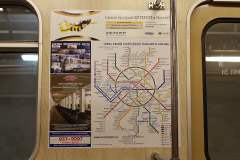Metro advertising efficiency in 2009.
A traditional market research dedicated to the Moscow metro advertising efficiency was carried out in April and May 2009. That was the sixth marketing project implemented by TNS Gallup Media by request of OOO “Olimp”, the underground visual communications market operator.
As before, the main research objectives were the evaluation of attentiveness of Moscow residents to the advertisement accommodated on the Metro territory and to particular advertising media types, as well as a description of passengers’ social-and-demographic structure.
Like previous projects the 2009 Metro Advertising Efficiency research included a telephone inquiry of Moscow residents from 16 years of age and up. The volume of a random double-stage sampling was 2005 accomplished interviews that represent the universe general population of 9.17 million people. The second part of the research was based on the information from 515 personal interviews that TNS Gallup Media personnel have carried out at various stations of the Moscow metro.
The telephone interviews showed that:
- On average 76% of Moscow adult population (about 6.9 million people) use the Metro every month, on average 34% of Moscow residents (over 3.1 million people) use the Metro every day.
- Almost 3.2 million people take at least one trip a day during week-days, and 2.8 million Moscow residents take at least one trip on week-ends.
- About 83% of passengers spend more than half-hour in the Metro.
The social-and-demographic image of the metro passengers: 



Consumers’ characteristics and life-style.
- Metro users spend their leisure time in a diversified manner visiting cafes, beauty shops, movie theaters, etc. More than half of the Metro passengers (3.5 million people) are active Internet users.
- Half of the passengers (50%) have cars (3.5 million people).
- The overwhelming majority passenger of Metro passengers (94%, 6.5 million people) own at least one item of household appliances and electronics. A considerable number of Moscovites own DVD devices (4.2 million people), desktop computers (3.7 million people) as well as digital cameras (2.9 million people) and mini centers (3.1 million people).
- About 60% of passengers (4.2 million people) currently use bank products. In this regard one third of the passengers have payroll plastic cards (2.3 million people) and about one-fourth has a demand deposit (1.7 million people).
Attention to advertisement in the Metro.
- About 90% of the metro passengers (86%, 6.0 million people) paid attention to advertisement in the Moscow metro at least once during the month prior to the inquiry. In this regard almost half of the passengers (45%, 3.1 million people) paid attention to advertisement during each trip.
- The following groups pay attention to advertisement more often than others:
- 16-54 years old women
- people with secondary education
- middle-class and well-off Moscow residents




When assessing the attentiveness to the advertisement carriers’ types TNS Gallup Media employees obtained the following results:
| Advertisement types |
Telephone inquiry results |
Results of personal interviews |
| This advertisement type is paid attention to |
At least sometimes (at least once a month)
Monthly reach |
During each trip |
At least sometimes (at least once a month)
Monthly reach |
During one average trip |
Regularly (always or often) “Effective reach” |
| Of the Monthly reach |
Of an average trip |

Stickers in metro cars |
69% |
34% |
Figures
were
not
asse-
ssed |
Figures
were
not
asse-
ssed |
Figures
were
not
asse-
ssed |
Figures
were
not
asse-
ssed |

Stickers on the car walls |
Figures
were
not
asse-
ssed |
Figures
were
not
asse-
ssed |
93% |
66% |
69% |
64% |

Stickers over underground train windows and doors |
Figures
were
not
asse-
ssed |
Figures
were
not
asse-
ssed |
82% |
45% |
52% |
42% |

Stickers on the car glass doors |
Figures
were
not
asse-
ssed |
Figures
were
not
asse-
ssed |
85% |
48% |
59% |
51% |

Stickers with the metro lines scheme in the cars |
48% |
17% |
Figures
were
not
asse-
ssed |
Figures
were
not
asse-
ssed |
Figures
were
not
asse-
ssed |
Figures
were
not
asse-
ssed |

Boards along the escalators |
77% |
47% |
90% |
58% |
68% |
61% |

Posters on the walls opposite the platforms |
48% |
23% |
89% |
48% |
57% |
50% |

Illuminated boards in the halls |
38% |
18% |
69% |
27% |
40% |
28% |

Boards without illumination in the halls |
Figures
were
not
asse-
ssed |
Figures
were
not
asse-
ssed |
60% |
23% |
34% |
20% |
* During the past 12 months about one fifth of Moscow passengers (19%, 1.3 million people) used addresses and/or phone numbers given in advertisements accommodated in the Moscow metro.
Metro advertising efficiency in 2008
Metro advertising efficiency in 2007
Metro advertising efficiency in 2006
Metro advertising efficiency in 2005
Metro advertising efficiency in 2004 |